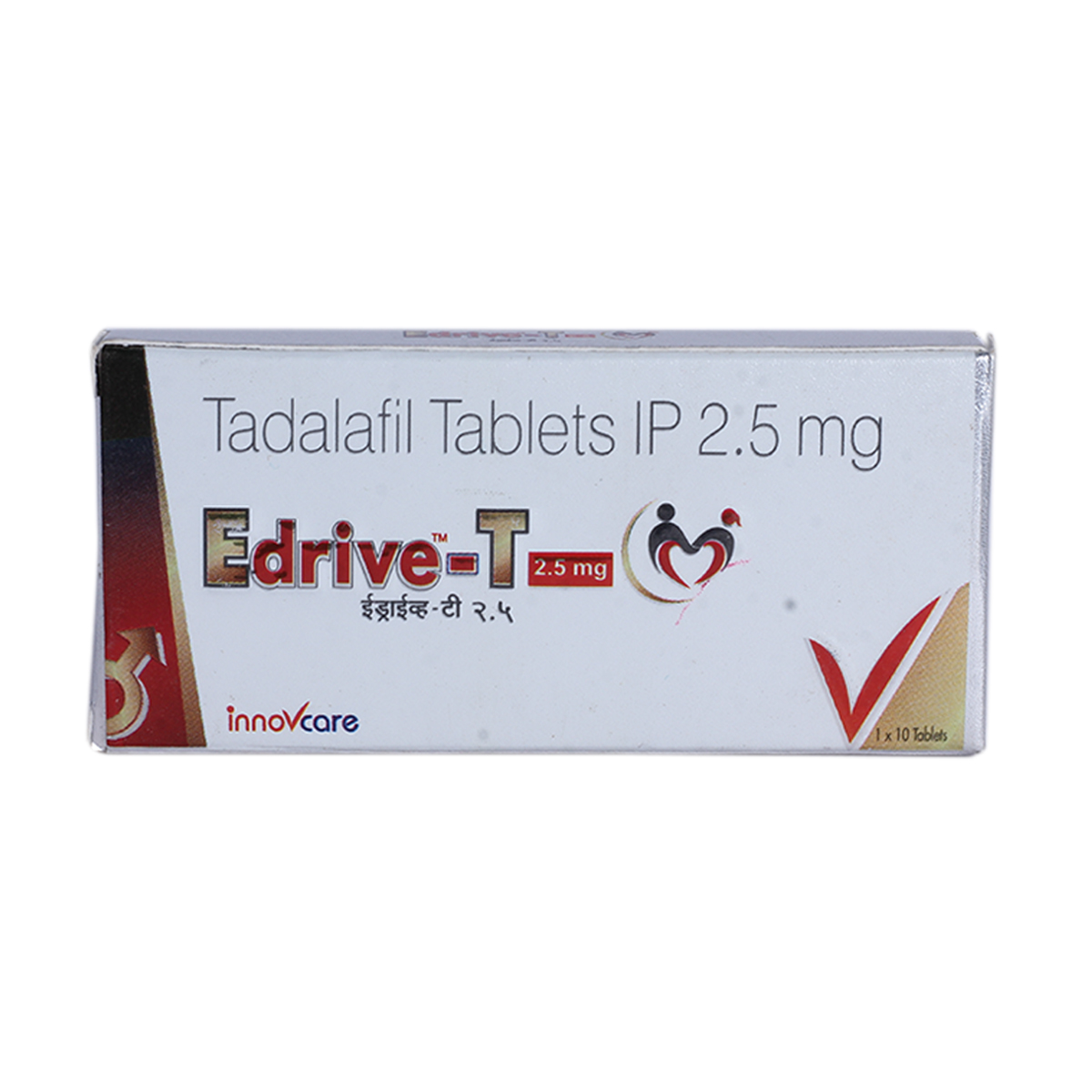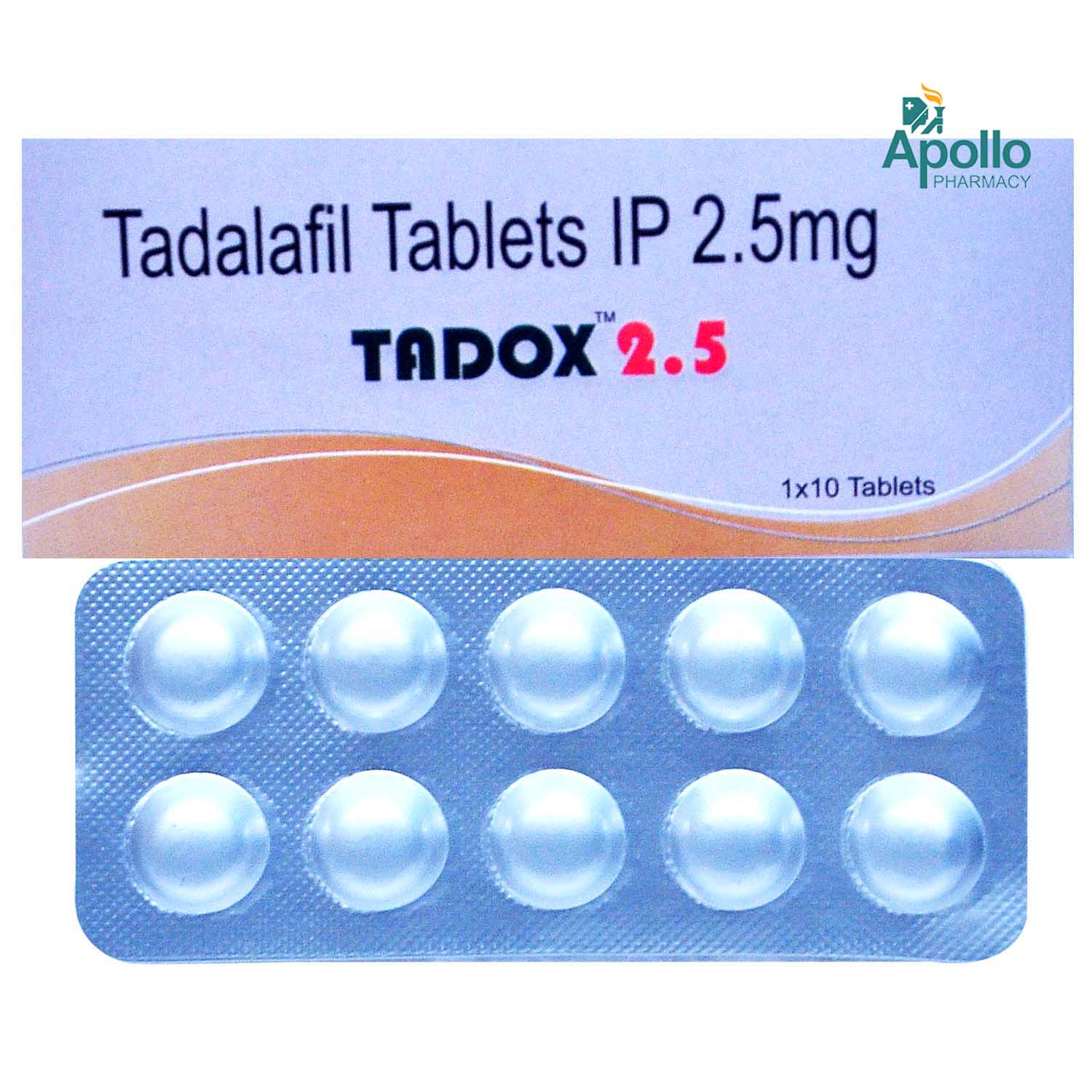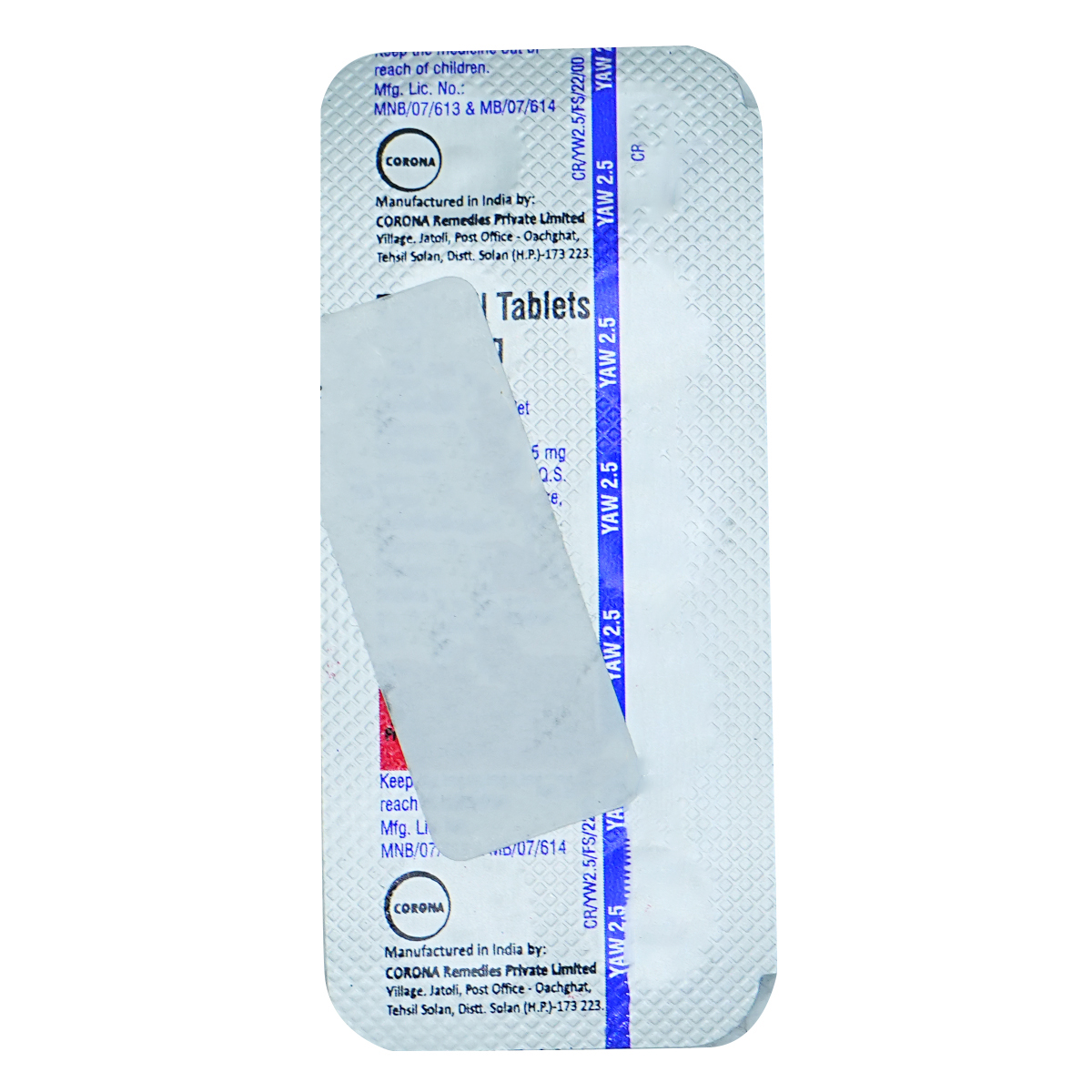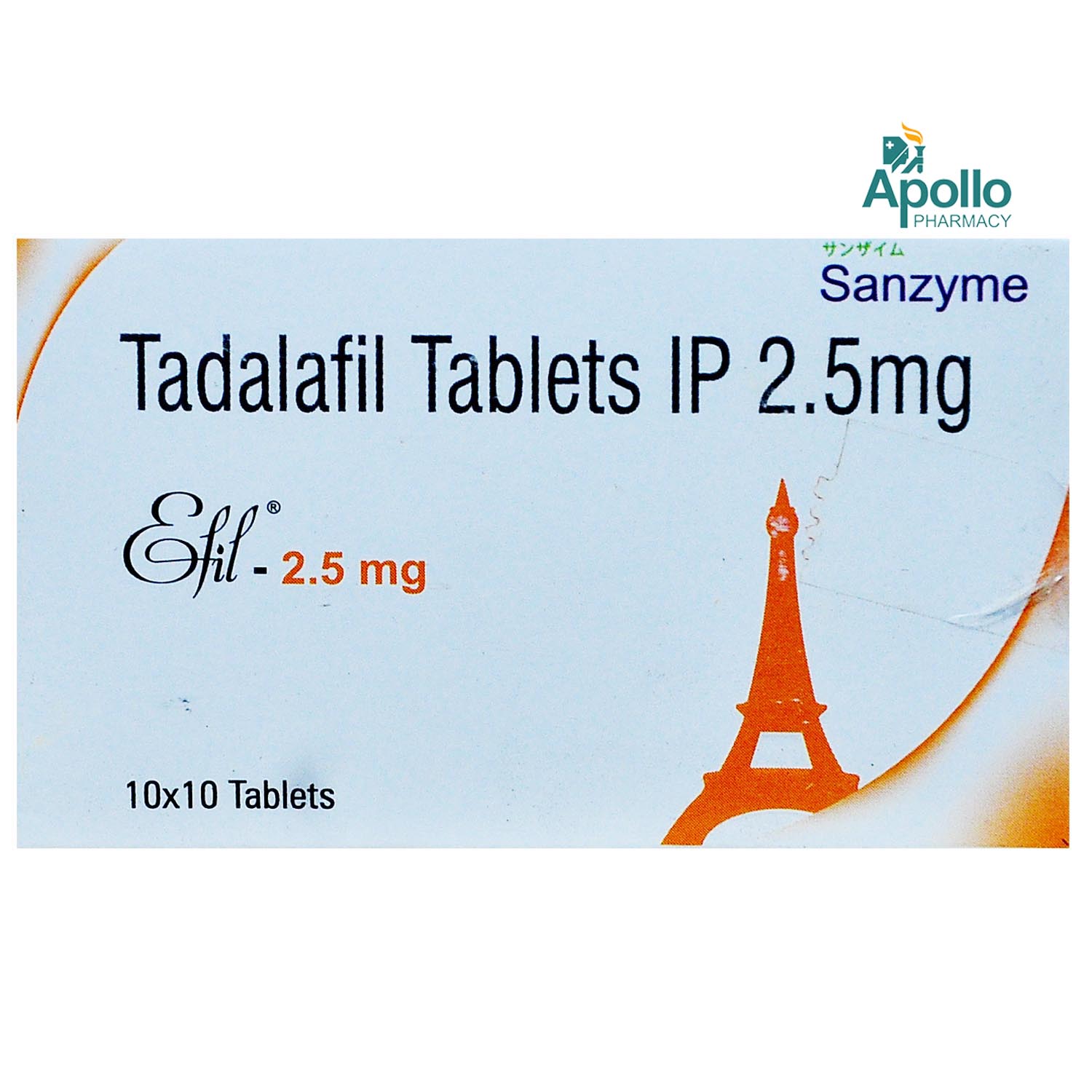Tadacent-2.5 Tablet 10's

MRP ₹146
(Inclusive of all Taxes)
₹21.9 Cashback (15%)
Extra 15% Off with Bank Offers
Written By Santoshini Reddy G , M Pharmacy
Reviewed By Bayyarapu Mahesh Kumar , M Pharmacy
know your delivery time
Provide Delivery Location
Composition :
TADALAFIL-2.5MG
Manufacturer/Marketer :
Lecent Healthcare Pvt Ltd
Consume Type :
Oral
Return Policy :
Not Returnable

Secure Payment

Trusted by 8 Crore Indians

Genuine Products
Therapeutic Class
Other Info - TAD0091
Author Details
We provide you with authentic, trustworthy and relevant information
FAQs
Disclaimer
While we strive to provide complete, accurate, and expert-reviewed content on our 'Platform', we make no warranties or representations and disclaim all responsibility and liability for the completeness, accuracy, or reliability of the aforementioned content. The content on our platform is for informative purposes only, and may not cover all clinical/non-clinical aspects. Reliance on any information and subsequent action or inaction is solely at the user's risk, and we do not assume any responsibility for the same. The content on the Platform should not be considered or used as a substitute for professional and qualified medical advice. Please consult your doctor for any query pertaining to medicines, tests and/or diseases, as we support, and do not replace the doctor-patient relationship.
Alcohol
Pregnancy
Breast Feeding
Driving
Liver
Kidney
Children
Product Substitutes
About Tadacent-2.5 Tablet 10's
Uses of Tadacent-2.5 Tablet 10's
Medicinal Benefits Mweb
Key Benefits
Directions for Use
Side Effects of Tadacent-2.5 Tablet 10's
Drug Warnings
Drug-Drug Interactions
TadalafilNitroprusside
Critical
Critical
Drug-Drug Interactions
Login/Sign Up
TadalafilNitroprusside
Critical
How does the drug interact with Tadacent-2.5 Tablet:
Taking Tadacent-2.5 Tablet with Nitroprusside can increase the risk or severity of low blood pressure.
How to manage the interaction:
Taking Tadacent-2.5 Tablet with Nitroprusside is generally avoided as it can lead to an interaction, but it can be taken if prescribed by a doctor. If you experience dizziness, or heart palpitations, seek immediate medical attention. Do not discontinue any medications without consulting a doctor.
Taking Tadacent-2.5 Tablet with Nitroprusside can increase the risk or severity of low blood pressure.
How to manage the interaction:
Taking Tadacent-2.5 Tablet with Nitroprusside is generally avoided as it can lead to an interaction, but it can be taken if prescribed by a doctor. If you experience dizziness, or heart palpitations, seek immediate medical attention. Do not discontinue any medications without consulting a doctor.
Critical
How does the drug interact with Tadacent-2.5 Tablet:
Taking Tadacent-2.5 Tablet with Isosorbide dinitrate can increase the risk or severity of low blood pressure.
How to manage the interaction:
Taking Isosorbide dinitrate with Tadacent-2.5 Tablet is not recommended, but it can be taken together if prescribed by a doctor. However, consult a doctor if you experience dizziness, or heart palpitations. Do not discontinue any medications without consulting a doctor.
Taking Tadacent-2.5 Tablet with Isosorbide dinitrate can increase the risk or severity of low blood pressure.
How to manage the interaction:
Taking Isosorbide dinitrate with Tadacent-2.5 Tablet is not recommended, but it can be taken together if prescribed by a doctor. However, consult a doctor if you experience dizziness, or heart palpitations. Do not discontinue any medications without consulting a doctor.
How does the drug interact with Tadacent-2.5 Tablet:
Taking Tadacent-2.5 Tablet with Riociguat may increase the risk or severity of lower the blood pressure.
How to manage the interaction:
Taking Riociguat with Tadacent-2.5 Tablet is generally not recommended as it can lead to an interaction, but it can be taken together if prescribed by a doctor. However, if you experience dizziness, headache, and nasal congestion consult a doctor. Do not discontinue any medications without consulting a doctor.
Taking Tadacent-2.5 Tablet with Riociguat may increase the risk or severity of lower the blood pressure.
How to manage the interaction:
Taking Riociguat with Tadacent-2.5 Tablet is generally not recommended as it can lead to an interaction, but it can be taken together if prescribed by a doctor. However, if you experience dizziness, headache, and nasal congestion consult a doctor. Do not discontinue any medications without consulting a doctor.
TadalafilAmyl nitrite
Critical
How does the drug interact with Tadacent-2.5 Tablet:
Taking Tadacent-2.5 Tablet with Amyl Nitrite can increase the risk or severity of low blood pressure.
How to manage the interaction:
Taking Tadacent-2.5 Tablet with Amyl nitrite is generally avoided as it can lead to interaction. They can be taken only when advised by a doctor. Seek immediate medical attention if you experience symptoms like dizziness, or heart palpitations. Do not discontinue any medications without consulting a doctor.
Taking Tadacent-2.5 Tablet with Amyl Nitrite can increase the risk or severity of low blood pressure.
How to manage the interaction:
Taking Tadacent-2.5 Tablet with Amyl nitrite is generally avoided as it can lead to interaction. They can be taken only when advised by a doctor. Seek immediate medical attention if you experience symptoms like dizziness, or heart palpitations. Do not discontinue any medications without consulting a doctor.
Critical
How does the drug interact with Tadacent-2.5 Tablet:
Coadministration of Tadacent-2.5 Tablet with Isosorbide mononitrate can increase the risk or severity of low blood pressure.
How to manage the interaction:
Taking Isosorbide mononitrate with Tadacent-2.5 Tablet is not recommended, but it can be taken together if prescribed by a doctor. However, consult a doctor if you experience dizziness, or heart palpitations. Do not discontinue any medications without consulting a doctor.
Coadministration of Tadacent-2.5 Tablet with Isosorbide mononitrate can increase the risk or severity of low blood pressure.
How to manage the interaction:
Taking Isosorbide mononitrate with Tadacent-2.5 Tablet is not recommended, but it can be taken together if prescribed by a doctor. However, consult a doctor if you experience dizziness, or heart palpitations. Do not discontinue any medications without consulting a doctor.
Severe
How does the drug interact with Tadacent-2.5 Tablet:
Coadministration of Ketoconazole with Tadacent-2.5 Tablet may increase the blood levels and effects of Tadacent-2.5 Tablet. This can increase the risk or severity of side effects.
How to manage the interaction:
Although taking Ketoconazole and Tadacent-2.5 Tablet together can result in an interaction, it can be taken if a doctor has prescribed it. However, if your condition worsens or you experience any symptoms like chest pain or tightness, irregular heartbeat, shortness of breath, consult a doctor. Do not stop using any medications without a doctor's advice.
Coadministration of Ketoconazole with Tadacent-2.5 Tablet may increase the blood levels and effects of Tadacent-2.5 Tablet. This can increase the risk or severity of side effects.
How to manage the interaction:
Although taking Ketoconazole and Tadacent-2.5 Tablet together can result in an interaction, it can be taken if a doctor has prescribed it. However, if your condition worsens or you experience any symptoms like chest pain or tightness, irregular heartbeat, shortness of breath, consult a doctor. Do not stop using any medications without a doctor's advice.
Severe
How does the drug interact with Tadacent-2.5 Tablet:
Using Tadacent-2.5 Tablet together with voriconazole may significantly increase the blood levels and effects of Tadacent-2.5 Tablet. This can increase the risk or severity of side effects.
How to manage the interaction:
Although taking Voriconazole and Tadacent-2.5 Tablet together can cause an interaction, it can be taken if your doctor has suggested it. However, if you experience nausea, shortness of breath, dizziness, lightheadedness, fainting, visual disturbances, ringing in the ears, vision or hearing loss, chest pain or tightness, irregular heartbeat, and/or priapism (prolonged and painful erection unrelated to sexual activity), contact a doctor right away. Do not discontinue any medications without consulting a doctor.
Using Tadacent-2.5 Tablet together with voriconazole may significantly increase the blood levels and effects of Tadacent-2.5 Tablet. This can increase the risk or severity of side effects.
How to manage the interaction:
Although taking Voriconazole and Tadacent-2.5 Tablet together can cause an interaction, it can be taken if your doctor has suggested it. However, if you experience nausea, shortness of breath, dizziness, lightheadedness, fainting, visual disturbances, ringing in the ears, vision or hearing loss, chest pain or tightness, irregular heartbeat, and/or priapism (prolonged and painful erection unrelated to sexual activity), contact a doctor right away. Do not discontinue any medications without consulting a doctor.
Severe
How does the drug interact with Tadacent-2.5 Tablet:
Coadministration of Miconazole with Tadacent-2.5 Tablet may increase blood levels and effects of Tadacent-2.5 Tablet. This can increase the risk or severity of side effects.
How to manage the interaction:
Although there is a possible interaction between miconazole and Tadacent-2.5 Tablet, you can take these medicines together if prescribed by a doctor. However, consult a doctor immediately if you experience shortness of breath, dizziness, visual disturbances, or irregular heartbeat. Do not stop using medications without a doctor's advice.
Coadministration of Miconazole with Tadacent-2.5 Tablet may increase blood levels and effects of Tadacent-2.5 Tablet. This can increase the risk or severity of side effects.
How to manage the interaction:
Although there is a possible interaction between miconazole and Tadacent-2.5 Tablet, you can take these medicines together if prescribed by a doctor. However, consult a doctor immediately if you experience shortness of breath, dizziness, visual disturbances, or irregular heartbeat. Do not stop using medications without a doctor's advice.
Severe
How does the drug interact with Tadacent-2.5 Tablet:
Coadministration of Tadacent-2.5 Tablet and Sildenafil may increase the risk of developing low blood pressure.
How to manage the interaction:
Coadministration of Tadacent-2.5 Tablet and Sildenafil can lead to an interaction, but it can be taken if a doctor advises. However, if you experience dizziness, headache, heart palpitations consult a doctor immediately. Do not stop using any medications without a doctor's advice.
Coadministration of Tadacent-2.5 Tablet and Sildenafil may increase the risk of developing low blood pressure.
How to manage the interaction:
Coadministration of Tadacent-2.5 Tablet and Sildenafil can lead to an interaction, but it can be taken if a doctor advises. However, if you experience dizziness, headache, heart palpitations consult a doctor immediately. Do not stop using any medications without a doctor's advice.
How does the drug interact with Tadacent-2.5 Tablet:
Using Tadacent-2.5 Tablet together with avanafil increases the risk or severity of low blood pressure.
How to manage the interaction:
Although there is a possible interaction between Tadacent-2.5 Tablet and Avanafil, you can take these medicines together if prescribed by a doctor. If you experience dizziness, or heart palpitations call a doctor. Do not stop using any medications without a doctor's advice.
Using Tadacent-2.5 Tablet together with avanafil increases the risk or severity of low blood pressure.
How to manage the interaction:
Although there is a possible interaction between Tadacent-2.5 Tablet and Avanafil, you can take these medicines together if prescribed by a doctor. If you experience dizziness, or heart palpitations call a doctor. Do not stop using any medications without a doctor's advice.
Drug-Food Interactions
TADALAFIL-2.5MGGrapefruit and Grapefruit Juice
Moderate
Drug-Food Interactions
Login/Sign Up
TADALAFIL-2.5MGGrapefruit and Grapefruit Juice
Moderate
Common Foods to Avoid:
Grapefruit Juice
How to manage the interaction:
Drinking large amounts of grapefruit juice with Tadacent-2.5 Tablet may increase the blood levels and effects of Tadacent-2.5 Tablet. Avoid or limit drinking grapefruit juice while being treated with Tadacent-2.5 Tablet.
Grapefruit Juice
How to manage the interaction:
Drinking large amounts of grapefruit juice with Tadacent-2.5 Tablet may increase the blood levels and effects of Tadacent-2.5 Tablet. Avoid or limit drinking grapefruit juice while being treated with Tadacent-2.5 Tablet.
Drug-Diseases Interactions
No Drug - Disease interactions found in our database. Some may be unknown. Consult your doctor for what to avoid during medication.
Drug-Diseases Interactions
Login/Sign Up
Drug-Drug Interactions Checker List
Habit Forming
Special Advise
Diet & Lifestyle Advise
All Substitutes & Brand Comparisons
RX
Out of StockMatfil 2.5 Tablet 10's
Matias Healthcare Pvt Ltd
₹65
(₹6.5 per unit)
55% CHEAPERRX
Out of StockDeta-M Tablet 10's
Meethi Pharmaceuticals
₹82.5
(₹8.25 per unit)
43% CHEAPERRX
Out of StockTolfil 2.5mg Tablet
Dorris Pharmaceuticals Pvt Ltd
₹102
(₹9.18 per unit)
37% CHEAPER

Have a query?
Buy Now
Add to Cart

_0.jpg?tr=q-85)







